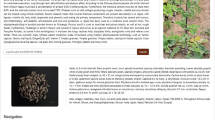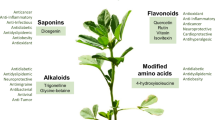Abstract
Guarana (Paullinia cupana var. sorbilis) is a plant native to the central Amazon basin. Roasted seed extracts have been used as medicinal beverages since pre-Colombian times, due to their reputation as stimulants, aphrodisiacs, tonics, as well as protectors of the gastrointestinal tract. Guarana plants are commercially cultivated exclusively in Brazil to supply the national carbonated soft-drink industry and natural product stores around the world. In this report, we describe and discuss the annotation of 15,387 ESTs from guarana seeded-fruits, highlighting sequences from the flavonoid and purine alkaloid pathways, and those related to biotic stress avoidance. This is the largest set of sequences registered for the Sapindaceae family.


Similar content being viewed by others
References
Abourashed EA, Toyang NJ, Choinski J Jr, Khan IA (1999) Two new flavone glycosides from Paullinia pinnata. J Nat Prod 62:1179–1181
Akashi K, Nishimura N, Ishida Y, Yokota A (2004) Potent hydroxyl radical-scavenging activity of drough-induced type-2 metallothionein in wild watermelon. Biochem Biophys Res Commun 323:72–78
Altschul SF, Madden TL, Schaffer AA, Zhang Z, Miller W, Lipman DJ (1997) Gapped BLAST and PSI-BLAST: a new generation of protein database search programs. Nucleic Acids Res 25:3389–3402
Antunes E, Gordo WM, de Oliveira JF, Teixeira CE, Hyslop S, De Nucci G (2001) The relaxation of isolated rabbit corpus cavernosum by the herbal medicine Catuama and its constituents. Phytother Res 15:416–421
Berube-Parent S, Pelletier C, Dore J, Tremblay A (2005) Effects of encapsulated green tea and Guarana extracts containing a mixture of epigallocatechin-3-gallate and caffeine on 24 h energy expenditure and fat oxidation in men. Br J Nutr 94:432–436
Birnboim HC (1983) A rapid alkaline extraction method for the isolation of plasmid DNA. Methods Enzymol 100:243–255
Brígido MM, Walter ME, Oliveira AG, Inoue MK, Anjos DS, Sandes EF, Gondim JJ, Carvalho MJ, Almeida NF Jr, Felipe MS (2005) Bioinformatics of the Paracoccidioides brasiliensis EST Project. Genet Mol Res 4:203–215
Bydlowski SP, D’Amico EA, Chamone DA (1991) An aqueous extract of guarana (Paullinia cupana) decreases platelet thromboxane synthesis. Braz J Med Biol Res 24:421–424
Campos AR, Barros AI, Santos FA, Rao VS (2003) Guarana (Paullinia cupana Mart.) offers protection against gastric lesions induced by ethanol and indomethacin in rats. Phytother Res 17:1199–1202
Davies C, Robinson SP (2000) Differential screening indicates a dramatic change in mRNA profiles during grape berry ripening. Cloning and characterization of cDNAs encoding putative cell wall and stress response proteins. Plant Physiol 122:803–812
Erickson HT, Corrêa MPF, Escobar JR (1984) Guaraná (Paullinia cupana) as a commercial crop in Brazilian Amazonia. Econ Bot 38:273–286
Escobar JR, Costa PRC, Corrêa MPF (1985) Variação do teor de cafeína na semente de guaraná em progênies de polinização aberta. Manaus: EMBRAPA-UEPAE de Manaus (Boletim de Pesquisa, 5)
Espinola EB, Dias RF, Mattei R, Carlini EA (1997) Pharmacological activity of Guarana (Paullinia cupana Mart.) in laboratory animals. J Ethnopharmacol 55:223–229
Eulgem T, Rushton PJ, Schmelzer E, Hahlbrock K, Somssich IE (1999) Early nuclear events in plant defence signalling: rapid gene activation by WRKY transcription factors. EMBO J 18:4689–4699
Felsenstein J (1998) PHYLIP—phylogeny inference package (Version 3.2). Cladistics 5:164–166
Frei B, Higdon JV (2003) Antioxidant activity of tea polyphenols in vivo: evidence from animal studies. J Nutr 133:3275S–3284S
Freitas DV, Carvalho CR, Nascimento-Filho FJ, Astolfi-Filho S (2007) Karyotype with 210 chromosomes in guarana (Paullinia cupana ‘Sorbilis’). J Plant Res 120:399–404
Fukumasu H, Avanzo JL, Heidor R, Silva TC, Atroch A, Moreno FS, Dagli ML (2006a) Protective effects of guarana (Paullinia cupana Mart. var. sorbilis) against DEN-induced DNA damage on mouse liver. Food Chem Toxicol 44:862–867
Fukumasu H, Silva TC, Avanzo JL, Lima CE, Mackowiak II, Atroch A, Spinosa H, Moreno FS, Dagli ML (2006b) Chemopreventive effects of Paullinia cupana Mart var. sorbilis, the guarana, on mouse hepatocarcinogenesis. Cancer Lett 233:158–164
Green P (1996) PHRAP documentation. University of Washington, Seattle. http://bozeman.mbt.washington.edu/phrap.docs/phrap.html
Grimplet J, Romieu C, Audergon J-M, Marty I, Albagnac G, Lambert P, Bouchet J-P, Terrier N (2005) Transcriptomic study of apricot fruit (Prunus armeniaca) ripening among 13006 expressed sequence tags. Physiol Plant 125:281–292
Henman AR (1982) Guaraná (Paullinia cupana var. sorbilis): ecological and social perspectives on an economic plant of the central Amazon basin. J Ethnopharmacol 6:311–338
Huang X, Madan A (1999) CAP3: a DNA sequence assembly program. Genome Res 9:868–877
IBGE, Instituto Brasileiro de Geografia e Estatística (2006) Sistema IBGE de Recuperação Automática (SIDRA). http://www.ibge.gov.br
Kato M, Kanehara T, Shimizu H, Suzuki T, Gillies FM, Crozier A, Ashihara H (1996) Caffeine biosynthesis in young leaves of Camellia sinensis: in vitro studies on N-methyltransferase activity involved in the conversion of xanthosine to caffeine. Physiol Plant 98:629–636
Kato M, Mizuno K, Fujimura T, Iwama M, Irie M, Crozier A, Ashihara H (1999) Purification and characterization of caffeine synthase from tea leaves. Plant Physiol 120:579–586
Kato M, Mizuno K, Crozier A, Fujimura T, Ashihara H (2000) Caffeine synthase gene from tea leaves. Nature 406:956–957
Kennedy DO, Haskell CF, Wesnes KA, Scholey AB (2004) Improved cognitive performance in human volunteers following administration of guarana (Paullinia cupana) extract: comparison and interaction with Panax ginseng. Pharmacol Biochem Behav 79:401–411
Lawrence SD, Cline K, Moore GA (1997) Chromoplast development in ripening tomato fruit: identification of cDNAs for chromoplast-targeted proteins and characterization of a cDNA encoding a plastid-localized low-molecular-weight heat shock protein. Plant Mol Biol 33:483–492
Mattei R, Dias RF, Espinola EB, Carlini EA, Barros SB (1998) Guarana (Paullinia cupana): toxic behavioral effects in laboratory animals and antioxidants activity in vitro. J Ethnopharmacol 60:111–116
Mazzafera P, Wingsle G, Olsson O, Sandberg G (1994) S-adenosyl-l-methionine: Theobromine 1-N-methyltransferase an enzyme catalyzing the synthesis of caffeine in coffee. Phytochemistry 37:1577–1584
Miura T, Tatara M, Nakamura K, Suzuki I (1998) Effect of guarana on exercise in normal and epinephrine-induced glycogenolytic mice. Biol Pharm Bull 21:646–648
Moyle R, Fairbairn DJ, Ripi J, Crowe M, Botella JR (2005) Developing pineapple fruit has a small transcriptome dominated by metallothionein. J Exp Bot 56:101–112
Murase T, Nagasawa A, Suzuki J, Hase T, Tokimitsu I (2002) Beneficial effects of tea catechins on diet-induced obesity: stimulation of lipid catabolism in the liver. Int J Obes Relat Metab Disord 26:1459–1464
O’Dea JA (2003) Consumption of nutritional supplements among adolescents: usage and perceived benefits. Health Educ Res 18:98–107
Ogawa M, Herai Y, Koizumi N, Kusano T, Sano H (2001) 7-Methylxanthine methyltransferase of coffee plants. Gene isolation and enzymatic properties. J Biol Chem 276:8213–8218
Oliveira CH, Moraes ME, Moraes MO, Bezerra FA, Abib E, De Nucci G (2005) Clinical toxicology study of an herbal medicinal extract of Paullinia cupana, Trichilia catigua, Ptychopetalum olacoides and Zingiber officinale (Catuama) in healthy volunteers. Phytother Res 19:54–57
Oraby HF, Ransom CB, Kravchenko AN, Sticklen MB (2005) Barley HVA1 gene confers salt tolerance in R3 transgenic oat. Crop Sci 45:2218–2227
Potter S, Uknes S, Lawton K, Winter AM, Chandler D, DiMaio J, Novitzky R, Ward E, Ryals J (1993) Regulation of a hevein-like gene in Arabidopsis. Mol Plant Microbe Interact 6:680–685
Ray S, Phadke S, Patel C, Hackman RM, Stohs S (2005) Short-term and long-term in vivo exposure to an ephedra- and caffeine-containing metabolic nutrition system does not induce cardiotoxicity in B6C3F1 mice. Arch Toxicol 79:330–340
Sanger F, Nickelen S, Coulson AR (1977) DNA sequencing with chain-terminating inhibitors. Proc Natl Acad Sci USA 74:5463–5467
Soares-Costa A, Beltramini LM, Thiemann OH, Henrique-Silva F (2002) A sugarcane cystatin: recombinant expression, purification, and antifungal activity. Biochem Biophys Res Commun 296:1194–1199
Sugisawa A, Kimura M, Fenech M, Umegaki K (2004) Anti-genotoxic effects of tea catechins against reactive oxygen species in human lymphoblastoid cells. Mutat Res 559:97–103
Sun Z, Gantt E, Cunningham FX Jr (1996) Cloning and functional analysis of the beta-carotene hydroxylase of Arabidopsis thaliana. J Biol Chem 271:24349–24352
Thompson J, Higgins D, Gibson T (1994) CLUSTAL W: improving the sensitivity of progressive multiple sequence alignment through sequence weighting, position-specific gap penalties and weight matrix choice. Nucleic Acids Res 22:4673–4680
Tobi SE, Gilbert M, Paul N, McMillan TJ (2002) The green tea polyphenol, epigallocatechin-3-gallate, protects against the oxidative cellular and genotoxic damage of UVA radiation. Int J Cancer 102:439–444
Uefuji H, Ogita S, Yamaguchi Y, Koizumi N, Sano H (2003) Molecular cloning and functional characterization of three distinct N-methyltransferases involved in the caffeine biosynthetic pathway in coffee plants. Plant Physiol 132:372–380
Weckerle CS, Stutz MA, Baumann TW (2003) Purine alkaloids in Paullinia. Phytochemistry 64:735–742
Yoneyama N, Morimoto H, Ye CX, Ashihara H, Mizuno K, Kato M (2006) Substrate specificity of N-methyltransferase involved in purine alkaloids synthesis is dependent upon one amino acid residue of the enzyme. Mol Genet Genomics 275:125–135
Acknowledgments
This work was supported by grants from the Ministry of Science and Technology and CNPq, process no 48.0120/2002-1. We are thankful to Ana Lúcia Assad, Flávio Neves Bittencourt, and Juçara Parra for the invaluable help and support on this project. We are grateful to Maria do Perpetuo Socorro Lira and Firmino José do Nascimento Filho for access to the Guarana Germoplasm Bank at Embrapa Western Amazon. The authors are thankful for critical and constructive suggestions for the article by Prof. Charles R. Clement and Rosa de Nazaré Silva Clement. We are also grateful for help in the sequencing and/or annotation by Andréa Vernes Fernandes, Jonso V. Souza, Maria Silvanira R. Barbosa, Marta Sofia Peixe Carepo, Rafaela Carvalho de Souza, and Viviane Basso Chiesa.
Author information
Authors and Affiliations
Consortia
Corresponding author
Additional information
Communicated by H. Judelson.
Rights and permissions
About this article
Cite this article
Ângelo, P.C.S., Nunes-Silva, C.G., Brígido, M.M. et al. Guarana (Paullinia cupana var. sorbilis), an anciently consumed stimulant from the Amazon rain forest: the seeded-fruit transcriptome. Plant Cell Rep 27, 117–124 (2008). https://doi.org/10.1007/s00299-007-0456-y
Received:
Revised:
Accepted:
Published:
Issue Date:
DOI: https://doi.org/10.1007/s00299-007-0456-y




